|
|
cOmE JoIn LeaRn in Japanese LaNgUaGe...(merged with lovelee)
[Copy link]
|
|
|
RELATED KAMI NAMES: Inari, O-Inari-San, Kodomo-no-Inari, Uga no Mitama no Kami, Ukemochi no Kami, Ogetsu-no-hime (Japanese food goddess), Lakshmi (India), Dewi Sri (Java), Ceres (Roman), Corn Maidens (Lakota), Yumil Kzxob (Mayan). ASSOCIATIONS: Protector of rice cultivation; patron of sword smiths; god of prosperity; patron of trade, merchants and rice farmers; associated with brothels and entertainers. SYMBOLS: hoshi-no-tama (star ball); pear-shaped emblem surmounted by flame like symbols (??); Cherokee word Inari means "gray fox;" English word for beautiful woman is "foxy" lady; rice wrapped in aburage (fried bean curd) is called Inari-zushi (Inari sushi), and is highly favored by the fox (and often given as on offering).
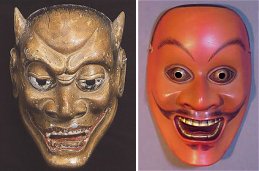 NOH MASKS NOH MASKS
L) Yakan. Chinese fox-like creature that climbs trees and roars like a wolf
from shofu.pref.ishikawa.jp/shofu/geinou_e/nougaku/4e/nougaku4-c_e.html
(R) Ko-tobide. The Fox Spirit in Noh Plays.
Mask used for the role of the fox spirit or demons in Noh Plays. |
|
|
|
|
|
|
|
|
|
|
|
*sofia...bagus laa..ngko tanya soklan camni..
ngan saza skali belajar menda nih..
BIG BUDDHA (DAIBUTSU)
Of the three most widely known giant effigies of Buddha from old Japan, only the Big Buddha in Kamakura (15 meters) remains in original form. The Nara Daibutsu (15 meters) was recast, while the famous Kyoto Daibutsu (48 meters) was entirely destroyed in a fire and replaced by a small wooden substitute.
There are many other giant and less giant Daibutsu statues in Japan. The oldest surviving Daibutsu sculpture in Japan, cast in 609 AD, is the Asuka Daibutsu (2.75 meters). Among stone-carved Daibutsu in Japan, the largest is the Daibutsu of Nihon-ji (31 meters), chiseled into a stone cliff during the 1780s. During the early years of Japanese Buddhism, especially during the Heian Era (794-1185 AD), many Buddhist deities were carved in stone on large rock outcrops, cliffs, or in caves. Known as Magaibutsu or Sekibutsu, these impressive carvings are found nationwide, but over half are located in Kyushu, the earliest inhabited area of Japan. Finally, the largest Big Buddha statue in Japan -- and reportedly worldwide -- is the recently constructed 120-meter Ushiku Daibutsu in Ibaraki Prefecture, just 50 km from Tokyo.
Ushiku Daibutsu
Hozo Bosatsu / Amida Nyorai
120 meters in height
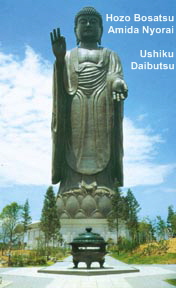
Ibaraki Prefecture, 50 km northeast of Tokyo. Originally known as Jodo Teien, this garden park is now referred to as Ushiku Arcadia, a place to retrace the journey of Hozo Bosatsu. Hozo, after countless ages of practice and faith, ultimately becomes the Amida Buddha. For a few more details on Hozo Bosatsu, click here.
The Ushiku Daibutsu (not sure of construction date; perhaps 1995 AD) is reportedly the tallest Buddhist statue in the world. One hundred meters in height, it is covered with 6-mm-thick bronze plates, and stands on a platform 20 meters high. One web site says this statue is three times taller and 30 times larger in volume than the Statue of Liberty
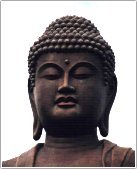 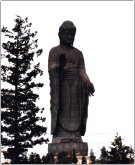 |
|
|
|
|
|
|
|
|
|
|
|
SHINTO - THE WAY OF THE GODS
Native Animistic Folk Religion of Japan
Shrine = Shinto Temple = Buddhism
Belief in spirits who can bring both good and evil.
Belief that all natural objects are inhabited by spirits (kami).
The modern community-based folk religion of Japan.
Many Shinto deities in Japan have taken on Buddhist attributes.
Many Buddhist deities in Japan have taken on Shinto attributes.
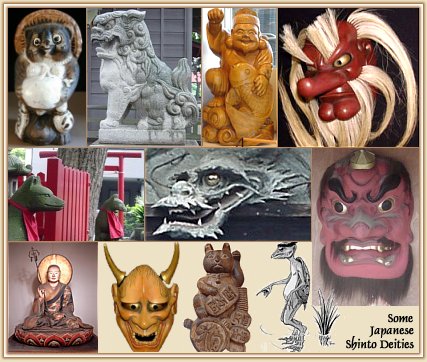
HISTORICAL NOTES
SHINTO. Literally "The Way of the Gods."
Shinto is the ancient native religion of Japan still practiced in a form modified by the influence of Buddhism and Confucianism. In its present form, Shinto is characterized less by religious doctrine or belief, than by the observance of popular festivals and traditional ceremonies and customs, many involving pilgrimages to shrines. Shinto, a term created to distinguish the indigenous religion from Buddhism, is the equivalent of the Japanese kami-no-michi, "the way of the gods." Shinto's places of worship are called "Shrines," while Buddhist places of worship are called "Temples."
Shinto existed centuries before the introduction of Buddhism to Japan (the latter arrived in Japan around the 6th century AD via China and Korea). Since then the two have interwoven intimately. Even today, Shinto shrines are found within Buddhist temples; the two continue to share deities despite earlier and aggressive government attempts to divide Japanese Buddhism and Shintoism into two distinct camps. A recent example is the merger of Inari, the Shinto god/goddess of rice, with Benzaiten, the Hindu/Buddhist goddess of art and music. The composite deity is known as Uga Benzaiten.
Shinto can be traced back to at least the Yayoi Period (300 BC). Interestingly, Shinto deities were not given anthropomorphic characteristics until the appearance of the Nihon Shoki (Chronicles of Japan, the "Nihongi"), one of Japan's earliest official records, compiled around 720 AD. Together with the Kojiki, another court-sponsored document of that time, the two were commissioned by Japan's leaders to demonstrate to the Chinese Emperor that the Yamato Dynasty (aka Japan) had a long and distinguished history -- thereby proving that Japan was a sovereign kingdom. In the process, however, it appears that the creators of these documents made up the names of 28 Japanese sovereigns, starting with the first emperor, Jimmu Tenno ("he who ascended from heaven"). These 28 rulers are probably fictional, although there are many Japanese who will argue otherwise.
Prior to the Nihon Shoki and the Kojiki, there was no tradition of Shinto sculpture. The lack of Shinto sculpture until around the 8th century AD is in stark contrast to Buddhism. Buddhism originated in India around 500 BC, then found its way to Japan many centuries later via Korea and China). Under Buddhism, the artistic impulse of mainland Asia blossomed for nearly 500 years before reaching Japan. By the 6th century, when Buddhism finally arrives in Japan, the volume of Buddhist paintings, sculptures, and temples in India, Southeast Asia, Tibet, China, and Korea is already impressive. |
|
|
|
|
|
|
|
|
|
|
|
Amaterasu and the Imperial Family
Emperor Akihito (the current emperor) is said to be the 125th direct descendant of Emperor Jinmu, Japan's legendary first emperor and a mythical descendent of Amaterasu, the Sun Goddess. Though not often referred to today, the Japanese calendar year starts from 660 BC, the year of his accession. The reigning emperors were considered to be the direct descendant of the Sun Goddess and revered as living gods at one time or another. When the Pacific War was imminent in 1940, the fascist government was boasting it was the year of 2600 to exalt the national prestige, and it even made a song cerebrating the 2600th year.
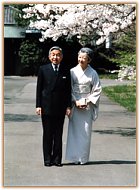 |
|
|
|
|
|
|
|
|
|
|
|
Sun imagery is still very prominent in modern Japan. Japan's national flag, the hinomaru (literally "sun circle"), symbolizes the sun, and was officially adopted by the Japanese Diet in August 1999, when the National Flag and Anthem Law was enacted. The exact origin of the hinomaru is unclear, but many point to the 12th century, when it appeared during a military campaign. Historically the hinomaru is a symbol of the reign of the "divine" emperor. The country's name, Nippon or Nihon, is typically translated as "Land of the Rising Sun" or "Source of the Sun." The country's national anthem, the kimigayo, also officially adopted in 1999, is a song of praise to the emperor. Its lyrics basically mean "May the emperor reign forever." The imperial family's crest, the chrysanthemum, is used on the cover of Japanese passports.
 Hinomaru Hinomaru
 Wartime Flag Wartime Flag
Kimigayo Lyrics
Kimi ga yo wa
Chiyo ni yachiyo ni
Sazare ishi no
Iwao to nari te
Koke no musu made
English Translation
May the Emperor's reign continue for
a 1000, nay, 8000 generations and for
the eternity it takes for small pebbles
to grow into a great rock and become
covered with moss. |
|
|
|
|
|
|
|
|
|
sofia This user has been deleted
|
ishk....tak sangka banyak betul info yg saza bagi... pening nak baca...
tapi kan gambar dia tak appear pun on screen?
nak lah jugak tengok gambar dia..at least syok sikit bila baca articles sekali 
mana saza dpt info ni semua? nanti bolehlah ceritakan pulak pasal every town in japan...kalau saza ada masa....
exam dah habis ker? |
|
|
|
|
|
|
|
|
|
|
|
alamak...tak kuar lak gambar..
semalam ok jekkkkk....
nanti laaa...saza carik yg baru sebab hari nih saza sibuk skit..
sebab esok saza kena bentang thesis esok kat depan sensei.. |
|
|
|
|
|
|
|
|
|
sofia This user has been deleted
|
thank you, banyak betul info...
saza, boleh tak cerita pasal food kat jepun?
boleh belajar sekali...nama japanese n camner nak pronounce
org jepun ada ker masalah obesiti?
kat sini rasa macam dah tak tercontol dah...
banyak advert suruh exercise.. 
dah nak masuk bulan puasa.... nanti mesti penuh masa bazaar ramadhan...
macam2 local food..tu yg susah nak resist tu 
okay,,good luck with your thesis |
|
|
|
|
|
|
|
|
|
|
|
dah selamat berjaya bentang thesis....banzai..banzai...
pasal japanese food...
kalo nak resepi....sofia pi jengah masuk board oversea..RESEPI ANTARABANGSA..
hehehehhe...ader resepi masakan jepun..tempura,ramen,sushi..
sorry...sofia..
obesiti tu aper???macam kesihatan ker????
owang jepun pandai jaga kesihatan...
kalo nak tahu..owang tua yg paling berusia di dunia..dah meninggal tahun lepas..
kat sini macam2 ubat dijual di farmasi..ubat utk diet pun ader...
diorang malam2 jogging...dan lagik satu..dari segi pemakanan diorang amik berat sgt
alaaaa...puasa kat sini tak semeriah cam kat mesia... |
|
|
|
|
|
|
|
|
|
sofia This user has been deleted
|
congrats...
food kat sana mahal ker?
obesiti tu penyakit lemak berlebihan---> gemuk
org jepun suka melancongkan?
biasanya dia melancong ker mana? |
|
|
|
|
|
|
|
|
|
|
|
kat sini sumer...barang mahal sofia...
tgk jek laaa....living cost nya plak...adoi...
sebagai contoh...1 tin pepsi kat jepun..kalo beli kat mesia bleh dapat 3 tin..
ooo...obesiti tu..gemuk..
saza tgk kat sini..pompuan pandai jaga bada walaupun dah kawin beranak pinak..
makanan diorang..sumernya tak bergoreng dan tak berminyak cam kat mesia..
owang jepun ..memang suka melancong..
ke mana diorang suka pergi tak tahu plak sofia..
kalo musim panas...diorang gi Hawaii..
kalo musim bunga...rasanya negara asia cam Malaysia..
Malaysia pemes pun sebab kilang/kedai jepun banyak kat mesia..
bayangkan la...Jaya Jusco,Isetan,Sogo..tu milik diorang..
tapi kat sini Sogo dah tak dek tau sebab Sogo dah jatuh muflis sebab masalah dalamannya..(kesnya sama cam Perwaja Steel) |
|
|
|
|
|
|
|
|
|
sofia This user has been deleted
|
boleh tak saza recommend any good text book utk belajar bhs jepun?
confuselah...terlampau banyak sgt kat book store
tak tahu mana yg okay
masa saza belajar pakai text book apa? |
|
|
|
|
|
|
|
|
|
|
|
masa blajar dulu ..buku teks free dan tak ingat laa buku apa
lagipun buku nihongo smernya ada kat mesia
..adoiiiiii..saza tak tau laa...sofia..
kalo sofia nak sgt...saza carik buku nihongo kat sini utk sofia.. |
|
|
|
|
|
|
|
|
|
|
|
saza chan....genki kai....mou jyuniji dayoo
nande mada mada netteinai noo |
|
|
|
|
|
|
|
|
|
|
|
ello..nemoo
ajar ler...sofia nihongo..
rasanya nemoo lebih terer dari saza kan??? |
|
|
|
|
|
|
|
|
|
|
|
hehehe tanak laa saza oit ..... nemoo tak reti pun
tahu sket2 jer ..... dah byk lupa
saza lagi terer..... |
|
|
|
|
|
|
|
|
|
|
|
nemoo...ngko jgn nak berdalih tau..
saza tau nemoo skang kat nippon.. |
|
|
|
|
|
|
|
|
|
sofia This user has been deleted
|
Originally posted by hirai_saza at 11-10-2004 11:15 PM:
masa blajar dulu ..buku teks free dan tak ingat laa buku apa
lagipun buku nihongo smernya ada kat mesia
..adoiiiiii..saza tak tau laa...sofia..
kalo sofia nak sgt...saza carik buku nihongo kat s ...
tak perlah tak naklah menyusahkan saza lak...
nanti sofia try check kat web...
nak tanya kalau nak beli dictionary japan -eng mana yg okay...
kira macam beginner leh guna |
|
|
|
|
|
|
|
|
|
sofia This user has been deleted
|
nemoo n saza sama2lah contribute exciting sikit...  |
|
|
|
|
|
|
|
|
|
| |
Category: Belia & Informasi
|